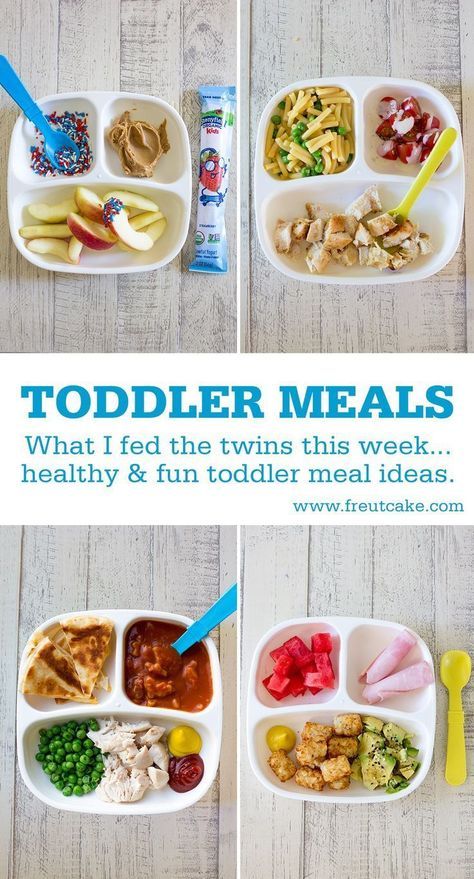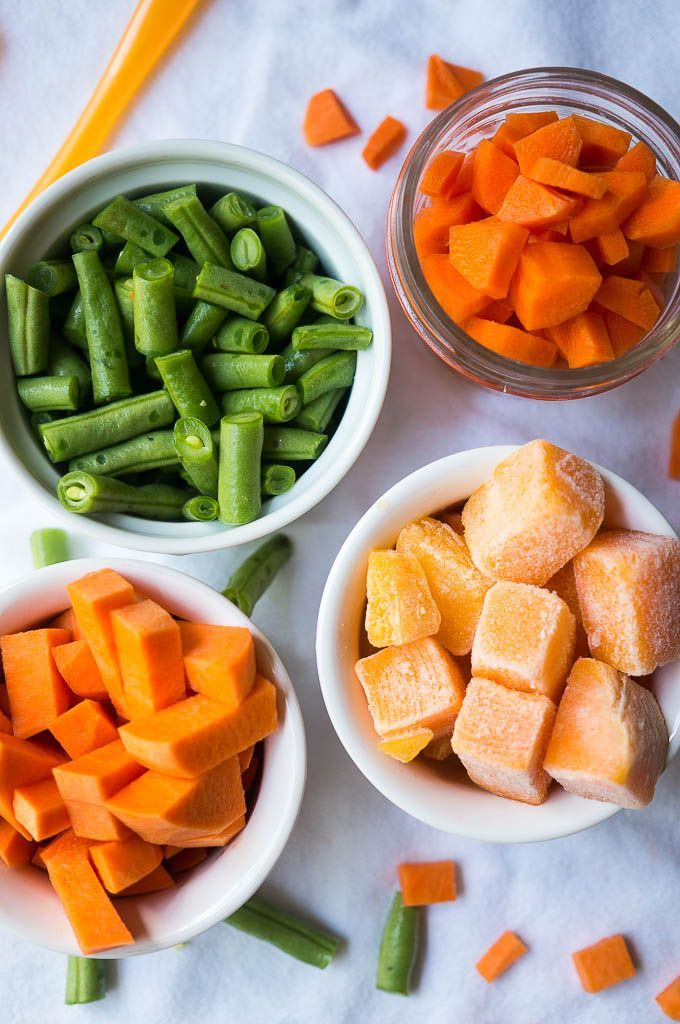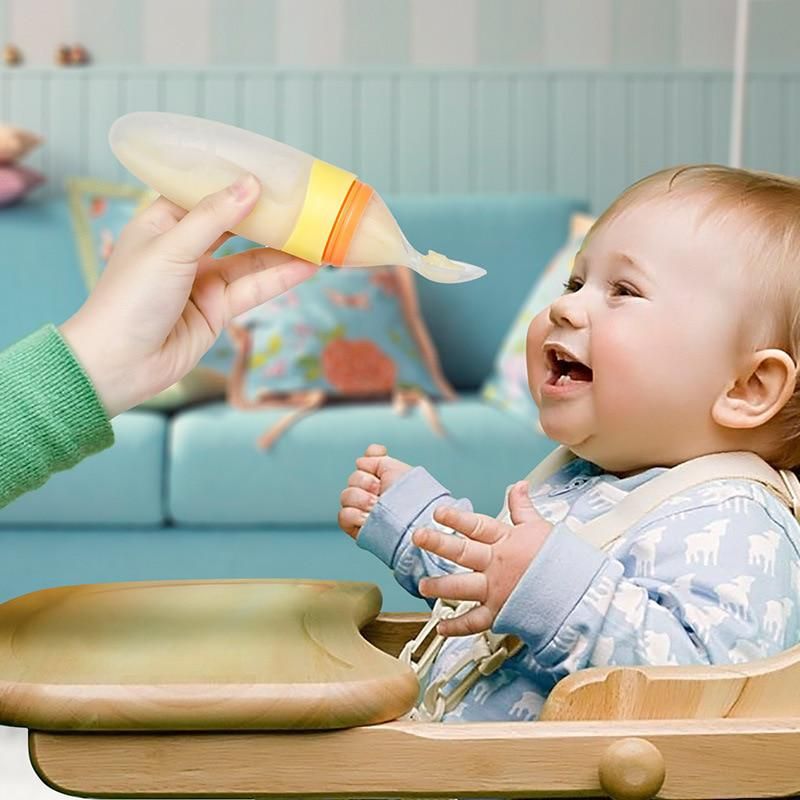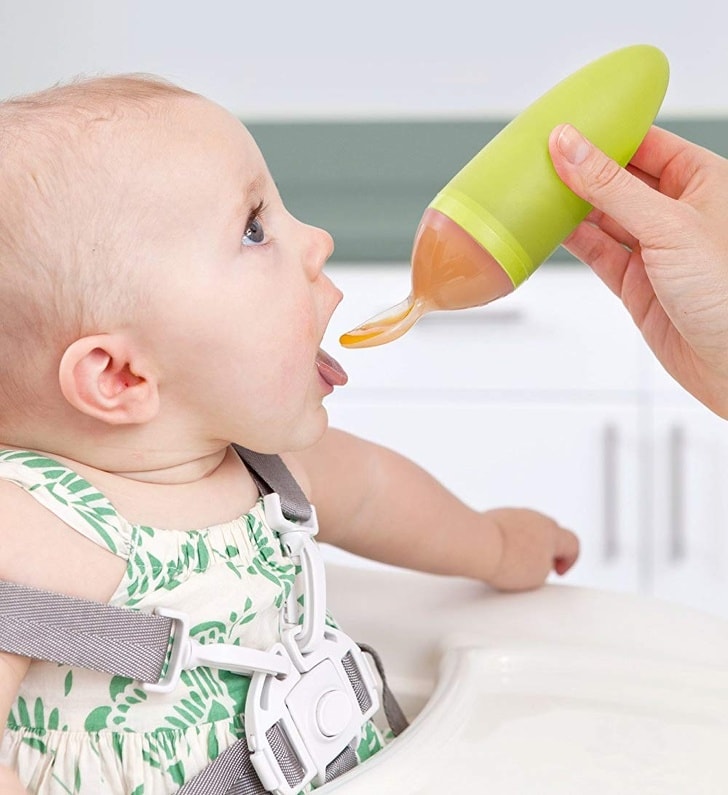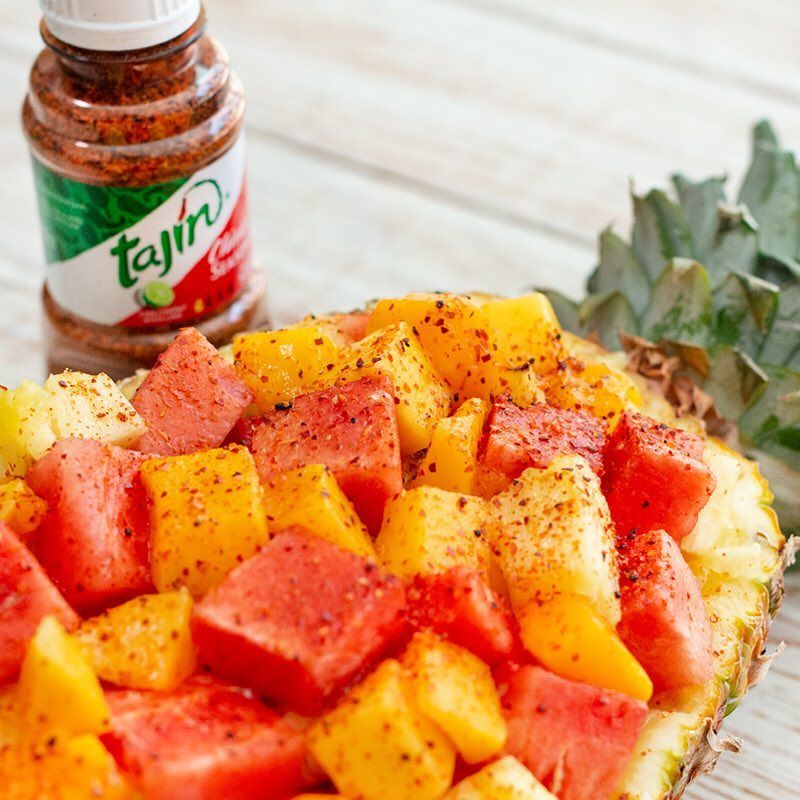Baby wants to feed himself
4 Mistakes that Slow Baby Self Feeding
Feeding your baby real food is an important step for all parents. But baby self feeding is a goal for all parents, especially during the first year of life.
The stakes are high for developing healthy food preferences and learning to eat, so don’t let these four common mistakes slow your baby down.
Baby feeding and the journey that goes with it is not always smooth-sailing, or easy.
In my many years of working with new mothers as a pediatric nutritionist, I know that the decisions made in this first year are always made with good intentions.
However, some decisions are made out of fear, hype, or lack of knowledge.
As a result, feeding mistakes that slow your baby’s abilities around self feeding can be made.
Don’t let them get in the way of really raising a healthy eater down the road.
Why is Starting Solids a Challenge?In a nutshell, the quick pace of food transitions your baby will make in the first year is the crux of most baby feeding mistakes.
In a period of 6 months, your baby will move from an all liquid diet to eating your family’s mealtime food.
That means the food transitions are fast.
Once you get used to one thing, it’s time to move on to the next.
For instance, you and your baby master pureed foods.
But, now your baby wants finger foods and seems unsatisfied with baby cereal.
Yes, the pace in the first year of life with food is quick.
Another challenge is the wide range of nutrients babies need in the first year.
Key nutrients for brain development, bone growth, and sufficient calories and protein for weight gain and kid’s growth should be top of mind.
Being mindful of these and fitting them all in can feel overwhelming.
If that isn’t enough to worry about, the repercussions of moving too slowly with food transitions can have its own set of ramifications.
For example, your baby may lose interest in infant rice cereal if they see it every day and at most meals.
Or, your baby may tire of exploring solid foods if she isn’t progressively challenged with new textures and flavors.
She may even prefer purees, baby food pouches, or get stuck on a liquid diet (hello, sippy cups of milk), if she isn’t challenged with more food flavors and textures.
If you’re like most parents I know, you want to get the baby food stages right.
From setting a reasonable baby feeding schedule to knowing when to start solids and make important baby food transitions, not only do you need to know what to do, you need to know what not to do, as well.
Signs You’re Hindering Self FeedingIf feeding your baby gives you a nagging feeling that things are getting off track or aren’t going as well as planned, you may be making some feeding mistakes.
Whether you need more information, or got the wrong advice, you may unknowingly be caught up in some very common mistakes.
If your baby isn’t gaining weight as predicted, is struggling with the spoon or baby led weaning, or if transitioning to a balanced meal plan isn’t going as well as you had hoped, you might be hindering your baby from moving forward with eating.
Your feeding style and approach may be counterproductive, especially if you’re using negative feeding practices.
Unfortunately, these can interfere with your baby’s eating, development, and food learning.
4 Self Feeding Mistakes You’ll Want to AvoidIn my line of work, I see several mistakes parents make when feeding their kids.
It’s not that I look for snafus, it’s just that when parents are really struggling, they show up on my doorstep.
As a way to help you side-step some of these challenges, I’ve outlined the top four feeding mistakes I see parents make with their baby.
Some are related to the process of feeding, while others involve food selection.
Mistake # 1: Trying to Keep Baby Clean while EatingIn the quest to stay clean and tidy (and lessen the laundry load), you may be swiping your baby’s mouth with a washcloth after every bite, staying with spoon feeding (because it’s cleaner), or avoiding messy foods to cut down on the time and effort it takes to clean up after a meal.
Why is this a mistake?
It robs your baby of important learning experiences, such as exposure to different textures, smelling food completely and learning how to manipulate food using his hands and mouth.
Serious investigation happens during meal time, and there’s no better way to learn about food than to get down and dirty with it.
Those pictures you see of babies covered head to toe in yogurt, spaghetti sauce and cake?
Yeah, that’s what I mean.
Case in Point:Long ago, I taught one of my clients to let her baby self feed with a spoon. I asked her to refrain from using the washcloth until the end of the meal, and charged her with the task of offering her daughter more food variety.
After implementing these interventions, both mom and baby started having a grand time with meals!
How to Keep Baby Clean While EatingUse the kitchen sink as a back-up bathtub.
Stock it with towels, soap and plastic measuring spoons and cups so your baby can go from high chair to kitchen tub (with supervision, of course) for a quick clean up.
Get the Food & Nutrients for Baby’s Brain!
Mistake #2: Spoon-feeding Your Baby for Too LongThis ties into #1 as a way to keep a cap on the mess.
But also, there may be a misconception that babies need to be spoon-fed for a year.
Not true.
Babies can begin the transition to chopped, table foods around 8 months of age.
And if you’re a follower of baby led weaning, you know that solids can be introduced at 6 months.
By one year, your baby should be eating table food. In other words, the food your family is eating.
You’ll just modify this into age-appropriate textures (shredded, chopped, etc), and encourage baby self feeding (with assistance as necessary).
Your baby should also be using an open-top cup with small amounts of liquid so that spills are minimal.
Of course, follow your baby’s developmental progress and cues for readiness to see when the time is right to transition to more textured finger foods.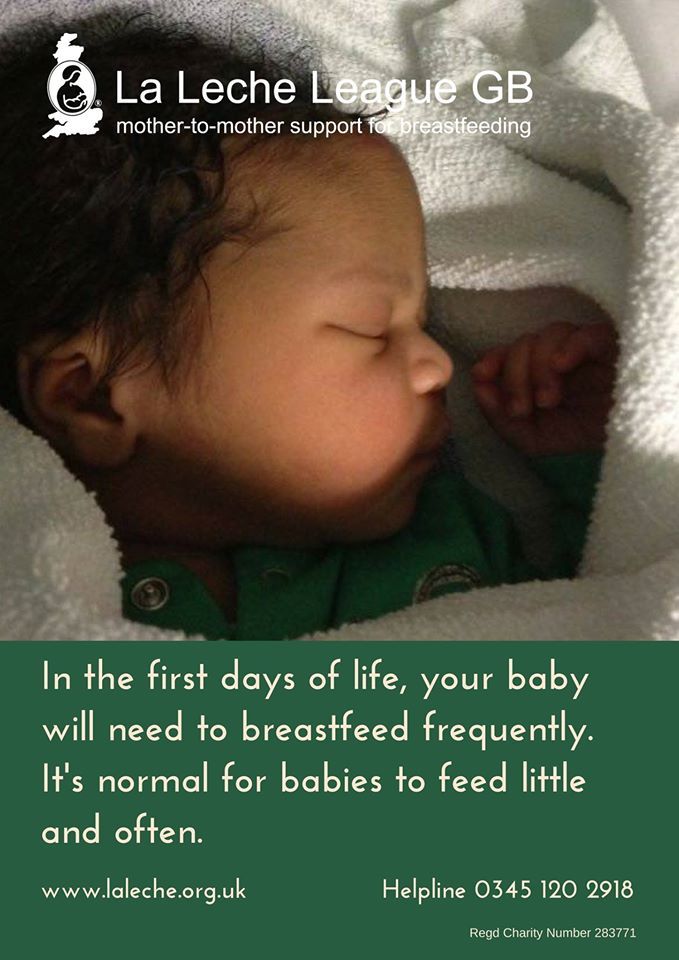
If you’re testing solid foods with a baby led weaning approach, be sure to read about iron and baby led weaning in this post or grab my up-to-date, step-by-step book called The Smart Mom’s Guide to Starting Solids.
It includes advice for spoon-feeding, baby led weaning and guidance for using both to optimize nutrients and self-regulation of eating.
When to Stop Spoon Feeding BabyBaby Ben was 14 months and still being spoon-fed.
He came to me because he wasn’t gaining weight and his length had fallen behind.
He was simply disinterested in the spoon—he wanted to feed himself, and he didn’t want mush anymore—he wanted the real food his family was eating.
Most babies will want to start self feeding between 6 and 8 months.
This usually coincides with the development of the pincer grasp.
While Ben’s mom was understandably afraid to give up spoon-feeding (because he wasn’t growing well and she wanted to be sure he ate enough), once she introduced table foods, gave him some independence, and let him eat to his own satisfaction, Ben started to thrive again.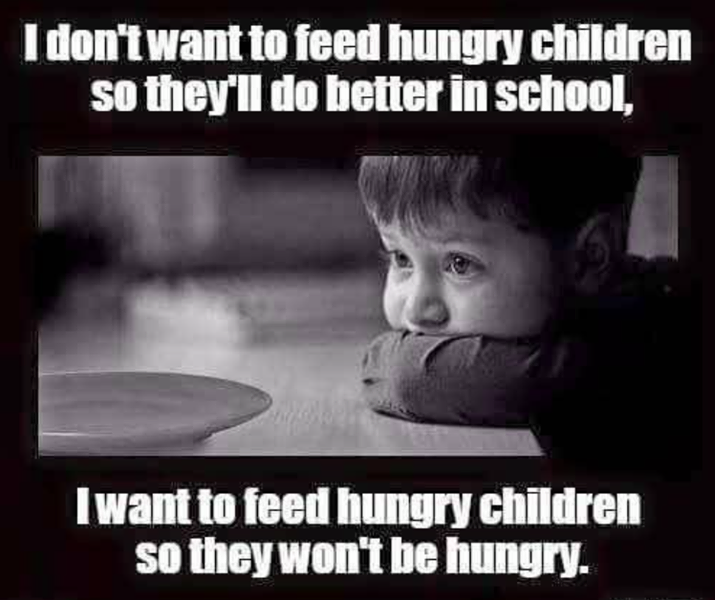
Most babies will want to start self feeding between 6 and 8 months. This usually coincides with the development of the pincer grasp. #startingsolids #selffeeding Click To Tweet
Mistake #3: Offering Foods that are Too HealthyI believe all babies should receive real, natural, unadulterated foods of all flavors, with an emphasis on food introduction and lots of food variety and exposure.
But I see a trend in feeding babies that emphasizes fruits, vegetables and whole grains.
This can become a problem because babies have limited stomach capacity and these foods are filling.
When your baby’s tummy is full, there’s a risk of missing other important foods and nutrients such as choline and DHA.
Whole grains, fruits and veggies also tend to be low in fat, which is an important nutrient for babies and their brain growth.
Certainly babies need these healthy foods, but they also need meat (or non-meat substitutes such as beans), fortified cereal, healthy fats and dairy (or fortified non-dairy) sources.
In fact, if I had the opportunity to re-write the food introduction guidelines, I’d advise the following:
- Meat First (because it’s full of iron, zinc, B vitamins, choline and other nutrients important for brain development.)
- Vegetables (because these are a learned taste and flavor and need more time and exposure for acceptance.)
- A variety of iron-fortified whole grains, fruit, and dairy products (or non-dairy alternatives if necessary, introduced as yogurt and cheese or as a baked in ingredient. (Note: no liquid milk until one year of age.)
Of course, there’s eggs, fish, peanuts, and nut butters — the food allergens that need to be introduced before 12 months, too.
My stance on “which foods first” is based on nutrient priorities and your baby’s budding flavor palate.
[Read: How to Introduce Peanuts to Your Baby]
Case in Point:Josh, at 13 months, was eating a high fiber diet, filled with whole grain breads, lots of vegetables and fruits, and very little added fat.
In fact, his mom stated,
“I never thought to add fat to his meals—I thought that would be unhealthy.”
Josh’s diet appeared very healthy on paper, but in reality, it wasn’t meeting his nutritional needs.
For example, babies need 40-50% of their total calories in the first year from fat.
Josh certainly wasn’t getting this.
Once Josh’s mom understood that babies need a good amount of fat daily and where and how to get it, she was able to plan more appropriate meals for him.
The added benefit?
With fat, foods (especially vegetables) were tastier and he ate better.
Mom opened up to more variety (French toast, pancakes, sandwiches, etc—all cut up in bite-sized pieces) and Josh enjoyed eating again.
Mistake #4: Allowing Bites or Gulps of Adult FoodsJust a little sip of my coffee? Sure.
A bite of my brownie? Why not!
What’s the harm in a little sip of soda, a taste of coffee, or a bite of a brownie?
Nothing immediate, but over the long haul, you might find your little infant growing up to be a soda swigging, sweet tooth kid if you’re not careful.
It’s true—what we offer babies now influences their taste preferences later on.
Regarding sweets for babies, I suggest holding out until age two.
The American Heart Association makes the same recommendation.
What about the one year birthday cake?
It’s ok because it’s not a “regular” offering.
Avoiding sugary foods early in life may help curb your baby’s sweet tooth.
She may kick the sweet preference into high gear later on, but you’ll have armed her with early exposure to healthier fare.
Remember I said those tummies are tiny?
They don’t give much leeway for sweets. I wouldn’t want you to sacrifice nutritious foods for them.
I also recommend holding off on caffeine, too.
Babies don’t need a stimulant (aren’t we mostly trying to calm them down?!), nor do toddlers or children for that matter.
There’s no place for caffeine in a child’s diet—so if you can manage to avoid it, bravo.
Last, artificial sweeteners and colors fall into this category too.
Try to limit them, especially for babies and young toddlers, even if “just one bite” seems harmless.
The dose relative to body weight is considerable.
I’ve searched and searched, and there’s no upside to offering artificial food colors to young children.
Move Forward with Self Feeding WisdomOf course, don’t beat yourself up if you’ve made any of the above baby self feeding mistakes.
Just take a step forward and make the adjustments you need to feed your baby well and with confidence.
That’s the fast path to encouraging self feeding and helping your baby move through his feeding and eating milestones.
Need More Help with Encouraging Self Feeding?My book, The Smart Mom’s Guide to Starting Solids is a quick read that cuts through the fluff and gives you exactly what you need to know to feed your baby in the first year.
A baby feeding schedule, baby feeding chart, baby food stages, baby food chart, when to start solids and more!
Grab your copy today!
Don’t forget to check out our workshops, classes and guidebooks to help you raise nourished children, inside and out.
BABY FEEDING MISTAKES | AVOID These 4 Mistakes & Start Your BABY on a HEALTHY EATING PLAN
Watch this video on YouTube
This post was updated September 2020 from its original.
Self-feeding: your baby may be ready sooner than you think
If you are starting your baby on solids, you may be in for a big surprise: your baby may be ready to self-feed mush earlier than you expect. Most parents start their baby with thin finely ground purees or baby cereal, gradually thicken them, eventually introduce lumpy food and finally transition to finger foods the baby self-feeds. But the truth is that many babies may be willing to try self-feeding from as early as 6-7 months of age, very soon after the solids are introduced.
Self-feeding case study.
Here is my recent experience with one of the families I am working with. The mom is a great cook, preparing wonderful homemade baby food, diligently following mealtime structure and providing top-notch nutrition to her 8-month-old baby. The baby girl successfully graduated from thin purees to chunky purees and soups.
The baby girl successfully graduated from thin purees to chunky purees and soups.
The main complaint: recently the baby lost interest in feeding and started fussing at mealtimes, stressing the mom and filling up on milk instead of enjoying solids. She did seem to enjoy eating with her fingers but her mom was not sure if it was age-appropriate and if she was able to get enough calories and nutrition this way.
Just let me do it myself!
I was lucky to get to observe a mealtime with the baby when I visited the family for assessment. The cute baby girl ate a few spoons of slightly mashed-up chicken soup but lost her interest very soon. The mother was very attuned to her baby, did not push the food when the baby lost interest in eating but she was concerned if the girl had enough.
So we decided to go for a little experiment and spooned some of the soup right on the tray. And then we both watched in awe the 8 months old baby enthusiastically picking the pieces of cooked chicken, carrots and noodles and happily transferring them into her mouth.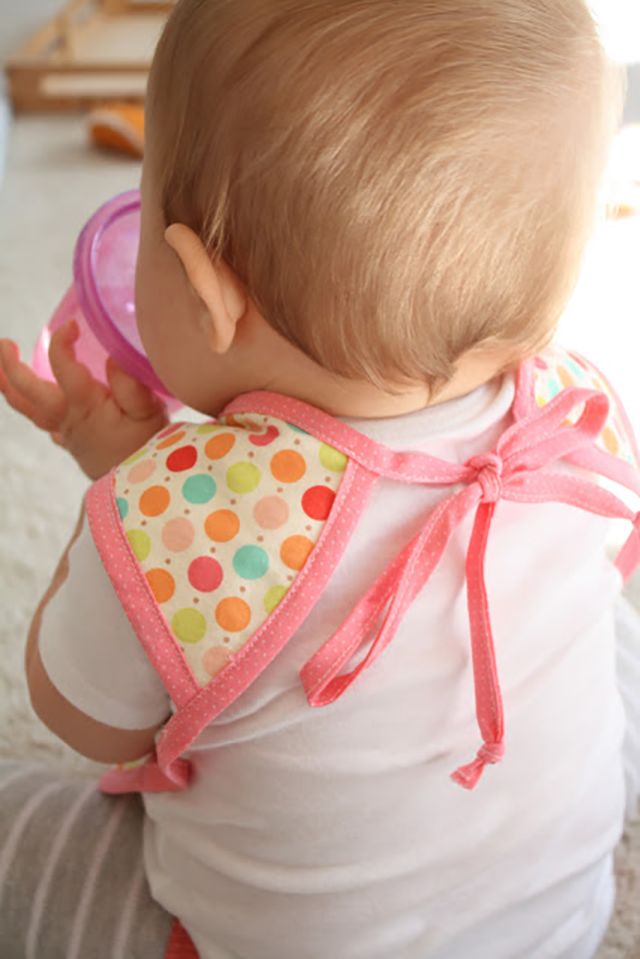 She ate a bowl of chicken soup from her tray all by herself!
She ate a bowl of chicken soup from her tray all by herself!
In my workshops and online classes, I encourage the parents to have no expectations when introducing solids and be prepared for all kinds of feeding scenarios. Here is an outline of some of the recommendations I make. I hope you will find them useful and look forward to hearing what worked for you with your baby!
1. Have an open mind. Every baby is different. Most need to follow the traditional puree-chunks-finger foods route but some babies want to self-feed from the very beginning. They will feed poorly unless allowed to eat independently. Or they go through the traditional sequence of texture upgrades within a few weeks and are ready and determined to self-feed at 7-8 months. Be guided by what your baby can do, not how old your baby is. As soon as the baby shows interest in self-feeding, allow her.
2. Pack up your suitcases for a trip. Timely texture upgrades will result in an early self-feeding and potentially broader diet. Studies here and here suggest a link between delayed progression from purees and a limited diet and feeding difficulties later in life.
Studies here and here suggest a link between delayed progression from purees and a limited diet and feeding difficulties later in life.
Feeding expert Ellyn Satter in her brilliant book “Child of Mine” says: “Teaching your baby to eat solids is like taking a trip, and like many trips, it has a destination. ….by the end of this first year, your baby is likely to be sitting up at your family table finger-feeding himself pieces of soft finger food and drinking from a cup. From the beginning of the trip to the end, you will be in constant transition. If you get settled with any one approach to feeding, you are likely missing something. If you get in trouble during this time, it is likely because you are looking for a predictable timeline to guide you through the many transitions. No such guideline exists – your baby is the only one who knows”.
3. Let them practice. Encourage your baby to self-feed and use utensils as soon as you start solid foods. Some babies may not be interested in either until 10 months or older but others may actually jump on this opportunity.
Some babies may not be interested in either until 10 months or older but others may actually jump on this opportunity.
I recommend giving babies some finger foods on a tray to allow them practice their motor skills at each meal. You can use baby cheerios, pieces of cooked fruit or vegetables like carrots or apples or soft raw fruit and vegetables like avocado, mango or cucumber cut in long strips.
4. Anticipate the mess. Self-feeding is rarely mess-free and it will not drive you crazy if you try to keep your baby and the floor clean. When my kids were starting to self-feed, I used to place their high chair on a large plastic mat, away from the walls, strip them to diapers and let them do whatever they needed to experience the food using all their senses. After the feeding, I would give them a quick rinse in a bathtub or kitchen sink.
In restaurants and friends’ homes, we used this super-bib with long arms that protected the clothes. By 12 months they were both self-feeding and starting to use utensils.
By 12 months they were both self-feeding and starting to use utensils.
5. Do not stress about calories. As kids start mastering a new way of eating and a new food texture, it may take so much of their energy and concentration, that their food intake may go down. Do not worry about it. They still drink plenty of breast milk or formula to close the potential calorie gaps.
The worst mistake you can make is to regress to the familiar texture like purees or a secure way of feeding with a spoon, in the hope to get more food inside your baby. Babies need opportunities to learn and it is our job as parents to trust them to push themselves with eating and challenge them appropriately at mealtimes.
How to teach a child to eat with a spoon by himself
Rastishka yogurts and curds are enriched with Ca and D3.
100 g of yogurt or cottage cheese provides 20-27% of the daily calcium requirement for preschool and school children.
About calcium
Rastishka
Teaching a baby to eat with a spoon on his own is an important and responsible task for a mother. You should not delay this, because the sooner the child starts to eat on his own, the easier it will be for parents, and these skills will come in handy in kindergarten.
www.2mm.ru
At what age should a child feed on their own?
At what age a child learns to eat with a spoon on his own depends on the parents.
All children are different: at the age of six months someone already reaches for a spoon and tries to keep it in a fist that is not yet strong, and someone even at 2 years old does not want to eat with a spoon himself. Some babies only begin to eat on their own by the age of 3-4 years. But! You should not let everything take its course and give up at the first setbacks. The more you take care of the baby, the later he will show his independence and the slower he will learn new things.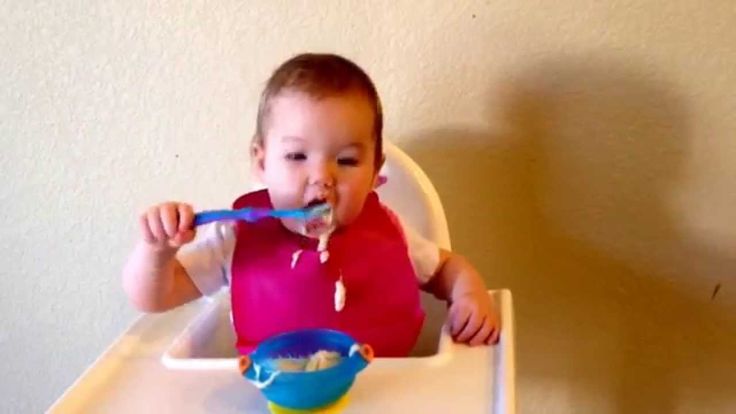
Take it for granted that when a baby is just learning to eat on his own, soiled clothes and food scattered all over the kitchen is normal. Take a breath and try not to be nervous. You may need to clean up and wash the "piggy" after every meal. Be patient - and everything will work out!
razvitie-krohi.ru
As a rule, by the age of 1.5 a child can already use a spoon on his own. But for this, from 7-8 months old, you need to let him examine cutlery, play with them, try to scoop something up, etc. Of course, mom will feed you faster, but you want to enjoy the success of your little one and the manifestations of his independence as early as possible, is not it.
How to choose a baby spoon
Does the baby need its own utensils? Definitely needed! In no case should adults eat from a baby spoon, lick it, etc. Pay attention to trusted manufacturers and high-quality food-grade plastic.
It is better to give water or medicine from a spoon so that there is no “tangle of the nipples”. Then the baby will want to chew on the spoon, to study. Keep it clean at all times. If defects, cracks, chips appear - change, because. the baby may get hurt.
Then the baby will want to chew on the spoon, to study. Keep it clean at all times. If defects, cracks, chips appear - change, because. the baby may get hurt.
agushkin.ru
- Metal (grandmother will definitely find the one “from which they fed you”) and even a silver spoon (a godmother’s gift, how could it be without it) is not the best option for a baby. Leave such spoons for older children.
- Silicone spoons are commensurate with the child's mouth and do not injure the mucous membrane and the first teeth.
- Comfortable cutlery for children with a curved handle.
- Good spoons with a rubberized handle, they do not slip out of the clumsy palm.
Tips for moms: how to teach a child to eat independently
The best way to teach is not to interfere!
- Use the special high chair. Move it to the table: and the child feels himself on an equal footing with everyone, and you are comfortable.

tvoymalysh.com.ua
- Cover the table and the floor under it, put on the baby's bib, prepare napkins if you need to wipe something.
Can be made into "overalls" out of dad's old shirt: easy to put on backwards and fasten at the back. Another life hack is a pillowcase with holes cut for the head and hands.
If the apartment is warm, you can leave a minimum of clothes on your child - you will have to wash less.
- Check the temperature of the food so that the child does not get burned or scared.
- Everything should be beautiful! Use bright dishes with pictures, interesting design of children's dishes.
- Prepare two spoons (better the same): one for the child, the second for yourself.
Let the child start eating by himself, and when he gets tired, help him without taking the spoon from his hands. If the baby is unable to collect food in a spoon on his own, you can offer him a spoon already filled with food.
There are situations when you are in a hurry or you think that your child will eat poorly or not enough on his own. You should not take away a spoon from him in order to properly feed him quickly. Haste in this matter is not welcome.
- Try to cut food into small pieces.
The child will be able to take food by himself. Do not scold if he starts to eat with his hands.
- Prepare dishes that stick well to a spoon: jelly, puree, cereals, cottage cheese, etc.
- Use unbreakable utensils.
- Buy a baby plate with suction cups or a rubberized bottom, then the baby will not carry it around the table and turn it over.
- Use the theme of food while playing with your child. For example, "Dinner party at the toys", games in the sandbox with a spatula, etc.
What if the child does not want to feed himself?
- Do not force feed your baby! Otherwise, he will hate food as a process, and it will be difficult for you to teach him to eat on his own in the future.

- Postpone training for a few days, if the baby is sick or just not in the mood, let him rest.
- Do not combine feeding with games, reading, watching cartoons. Otherwise, the baby will get used to it, and this is harmful for digestion, because. saliva is secreted in smaller quantities, which means that food is poorly digested.
- While feeding the baby, ask other family members to also be at the table and actively eat with spoons.
When the baby sees that the brother eats with a spoon, he might also want to try.
- Invite other children who can already feed themselves. Have a joint lunch.
- Don't let your baby watch cartoons, indulge and be distracted at dinner, focus on the main thing - teaching the child to eat with a spoon on his own.
- Do not rush the child.
- If you started to teach your child to eat on their own, do not back down. And warn other family members that from now on the baby eats on his own, he does not need help.
Don't do for your child what he can do for himself!
- If at some point the baby refuses to take a spoon, do not insist, do not force.
- Do not apply large portions. It is better to let the baby ask for supplements when he eats everything himself.
Video: how to teach a child to eat with a spoon
Dear readers! Share stories about how your baby learned to eat in the comments. What cutlery do you prefer?
SEE ALSO
26 545
Reviews and articles
Rastishka
article
Children's birthday party in the style of minions: a detailed guide
Surely not only a minion lover lives in your apartment, but also the "heroes of the occasion" themselves - funny yellow-mouthed creatures that look ...
Rastishka
article
Minion making: do-it-yourself storage containers
Funny and cool yellow and blue minions can be made from any materials at hand. And do it not just for fun, but with ...
And do it not just for fun, but with ...
Rastishka
article
Minion mania: how to make minions with your own hands
load more
The child does not want to eat on his own? Psychologist's advice
One of the most common problems in new mothers is the child’s unwillingness to refuse complementary foods and finally sit down at the table, eating with the help of cutlery on their own. This issue becomes especially urgent if the period for mastering such a skill is already suitable for the age of the baby.
As a rule, by the year the child begins to chew and bite solid food. By the age of 1.5, he becomes the full owner of his spoon, confidently holds it and scoops soup with it.
But what to do if the baby has long crossed the annual threshold, but still continues to eat from his mother's hands, and every attempt to seat him at the table ends in failure?
Possible reasons why the child did not start eating on his own:
1.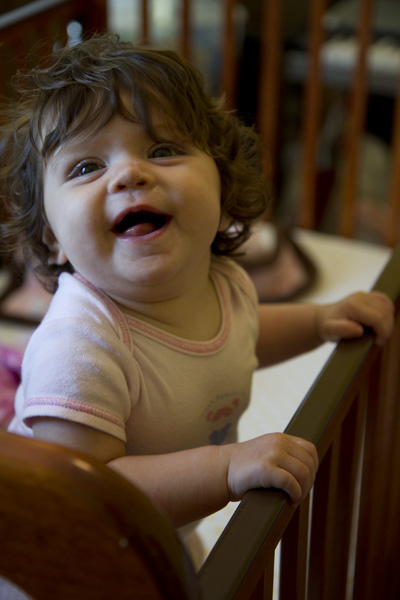 Were you afraid that the baby would choke on solid food, and each time you grind it into gruel? Alas, now the child does not want to eat on his own. He just got used to his diet and does not want to part with it.
Were you afraid that the baby would choke on solid food, and each time you grind it into gruel? Alas, now the child does not want to eat on his own. He just got used to his diet and does not want to part with it.
2. Time. “There is a time for everything” is a well-known proverb. If the child is less than 1.5 years old, it is quite possible that his “time” has not yet come. Each child is individual, and it is absolutely normal to lag behind their peers in some skills, and in some, on the contrary, overtake them.
3. The constitution of the body. For someone, a handful of salad sprinkled with olive oil is enough, and for someone, a piece of meat with a side dish and a cold dish for an aperitif will not be enough to saturate. Perhaps your child is one of those lucky ones who are predisposed to eat a little less than required. Or he might just not be hungry. In any case, do not force the baby to eat by force. He must be hungry so that the instinct for food consumption begins to work to the fullest.
4. Your assertiveness. It follows from the previous paragraph that the obsessive desire to feed the child only exacerbates the problem. He remembers your tearful requests to eat a dish or an increase in tone on it, and then reproduces "table" memories in a negative context. No need to force the child to eat if he does not want to. If he wants, he will do everything to get what he wants.
5. Psychological trauma or neurotic reactions. Perhaps, during the meal, the baby was frightened - he heard a loud cry or choked. Negative emotions remained in the memory, so now the baby can only take food from the mother's hands.
6. Too gentle upbringing. Imagine that you lived in your comfort zone for a long time, everything was available to you, you were spoon-fed, love and comfort were with you throughout the day. And you didn't do anything about it. And now they took that away from you and told you to take some action yourself. Difficult? That's hard for a kid. He needs time to get out of his comfort zone, where he lived and grew up quietly. Give your child some time and motivate him to eat on his own.
Give your child some time and motivate him to eat on his own.
7. Prolonged breastfeeding. One of the most common reasons why a child does not want to eat on his own. Complementary foods should begin to be introduced into the baby's diet no later than 6 months of age, and by the year, ordinary food should make up 90% of the total food allowance. Breast milk in this age period can be a supplement to meals, as well as a nightly supplement. Otherwise, if breastfeeding is the main food for a baby for a year, then you will not only have problems with independent food intake, but also refuse to consume many foods that are important for harmonious growth and development. You can (and should) solve this problem by gradually replacing breast milk with regular food. In the event that it is not possible to “roll up” the GV, it is best to consult with a specialist.
Problems best diagnosed by a specialist:
1. Psychological conflict.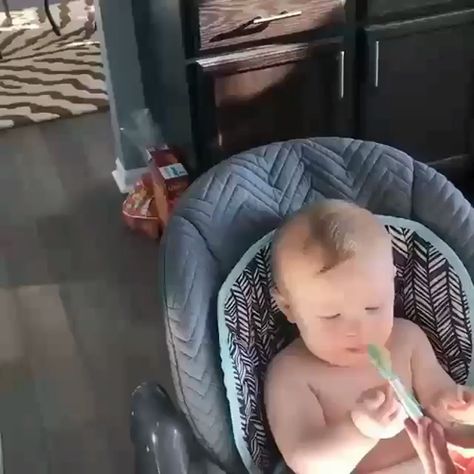 The child does not want to eat on his own in a year because of the barriers created in the head, provided by the parents in the first year of the baby's life. He eagerly remembers all the habits of his parents, their commitment, for example, to healthy food or hatred of meat, etc. Only a thorough conversation between parents and a specialist can help break down these barriers.
The child does not want to eat on his own in a year because of the barriers created in the head, provided by the parents in the first year of the baby's life. He eagerly remembers all the habits of his parents, their commitment, for example, to healthy food or hatred of meat, etc. Only a thorough conversation between parents and a specialist can help break down these barriers.
2. Rumination is a special type of gag reflex in infants. It is characterized by the reverse swallowing of vomit, while nausea is not observed. If vomiting continues, eating is accompanied by neurosis. These children also have an increased sensitivity of the stomach. Therefore, it is better to consult a doctor as soon as possible and identify violations in the digestive system. The specialist will select an individual nutrition plan for the baby and identify his intolerance to various dishes.
3. Complete refusal of food. Again, this is due to the disturbed psyche of the child. It can be characterized as a protest towards parents, hatred for certain foods, unwillingness to change the type of food (prolonged breastfeeding), etc.
It can be characterized as a protest towards parents, hatred for certain foods, unwillingness to change the type of food (prolonged breastfeeding), etc.
4. Feeling unwell. The child does not want to eat on his own, not because of his own whims, but because of illness. Try to take him to the doctor as soon as possible so that prolonged malnutrition does not lead to new problems.
How can I help my baby learn to feed on his own?
There are many ways to make the child want to eat himself. The main thing is to convince him that he is in a fairly comfortable environment for him.
1) Involve him in independently overcoming the current problem. Do not complicate your life - let him eat when he really wants to.
2) Be sure to consider his individual preferences. Do we eat what we don't like? No. So the child eats what he likes. Of course, this is not a reason to feed the baby with "bad" food, come to a consensus on this issue.
3) Accompany your meal with small interactive games: games “for mom, for dad”, “airplane flies”, etc. You can come up with whatever your imagination desires. Just remember - the child at this moment should want to eat.
4) Decorate dishes, buy colorful dishes. For example, warm shades of red, yellow, orange encourage food intake. All shades of blue, too. Thus, the baby will associate food with a positive, which means that he will be comfortable eating on his own.
5) Sit at the table when you eat yourself. The kid should get used to family dinners. At first, offer not a standard portion, but a micro one. For example, a slice of cucumber, bread or an apple. Gradually transfer to the "common" table.
6) Do not create multiple snacks. Try to follow the diet. In a year, a child has enough breakfast, lunch, afternoon tea and dinner. At this age, one night feeding is not excluded. If in between meals you supplement your baby (fruits, baked goods, dairy products, etc.



